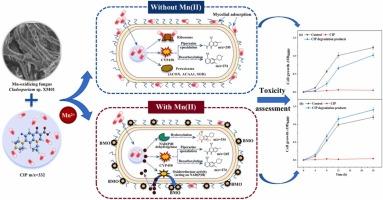锰氧化真菌Cladosporium sp. XM01降解环丙沙星的性能及转录组分析
IF 11.3
1区 环境科学与生态学
Q1 ENGINEERING, ENVIRONMENTAL
引用次数: 0
摘要
生物氧化锰(Mn)是一种很有前途的去除废水中环丙沙星(CIP)的方法,但Mn生物氧化与CIP降解之间的相互作用尚不清楚。本研究以锰氧化真菌Cladosporium sp. XM01为模型菌株,探讨了CIP对微生物生长、功能和生物转化的影响。结果表明,CIP对XM01的生长和Mn(II)氧化能力有促进作用。经过192 h的培养,在不添加Mn(II)的情况下,XM01对CIP的去除率为39.80% ~ 69.19%,而在添加300 μM Mn(II)的情况下,对CIP的去除率超过84%,表明了Mn(II)对CIP的直接和间接降解作用。转录组学分析显示,上调核糖体、过氧化物酶体和酪氨酸代谢途径增强了XM01对CIP的适应,并支持微生物的生长。细胞色素P450 (CYP450)酶是CIP降解的关键介质。此外,在Mn(II)存在下,跨膜转运蛋白、NAD(P)H脱氢酶和CYP450的进一步上调表明Mn的生物氧化增强了XM01对CIP的适应和应答,从而加速了其降解。提出的CIP降解途径包括哌嗪环氧化、脱羧和羟基化。本研究促进了对真菌Mn氧化在抗生素去除中的作用的认识,强调了其在废水处理中的潜力。本文章由计算机程序翻译,如有差异,请以英文原文为准。

Biodegradation of ciprofloxacin by a manganese-oxidizing fungus Cladosporium sp. XM01: Performance and transcriptome analysis
Biogenic manganese (Mn) oxidation presents a promising approach for ciprofloxacin (CIP) removal from wastewater, yet the interaction between Mn bio-oxidation and CIP degradation remains unclear. The Mn-oxidizing fungus Cladosporium sp. XM01 was selected as a model strain in this study, to explore the impacts of CIP on microbial growth, function and biotransformation. Results showed that CIP exhibited a promotive effect on the growth and Mn(II) oxidation capacity of XM01. After 192 h of cultivation, 39.80 %–69.19 % of CIP was removed by XM01 in the absence of Mn(II), while over 84 % was removed with 300 μM Mn(II), demonstrating both direct and Mn(II)-enhanced indirect degradation of CIP. Transcriptomic analysis revealed that the upregulation of ribosome, peroxisome, and tyrosine metabolism pathways enhanced XM01’s adaptation to CIP and supported microbial growth. Cytochrome P450 (CYP450) enzymes were implicated as key mediators in CIP degradation. Additionally, in the presence of Mn(II), the further upregulation of transmembrane transporters, NAD(P)H dehydrogenase, and CYP450 indicated that Mn bio-oxidation enhanced XM01’s adaptation and response to CIP, thereby accelerating its degradation. Proposed CIP degradation pathways include piperazine epoxidation, decarboxylation, and hydroxylation. This study advances the understanding of fungal Mn oxidation in antibiotic removal, emphasizing its potential in wastewater treatment.
求助全文
通过发布文献求助,成功后即可免费获取论文全文。
去求助
来源期刊

Journal of Hazardous Materials
工程技术-工程:环境
CiteScore
25.40
自引率
5.90%
发文量
3059
审稿时长
58 days
期刊介绍:
The Journal of Hazardous Materials serves as a global platform for promoting cutting-edge research in the field of Environmental Science and Engineering. Our publication features a wide range of articles, including full-length research papers, review articles, and perspectives, with the aim of enhancing our understanding of the dangers and risks associated with various materials concerning public health and the environment. It is important to note that the term "environmental contaminants" refers specifically to substances that pose hazardous effects through contamination, while excluding those that do not have such impacts on the environment or human health. Moreover, we emphasize the distinction between wastes and hazardous materials in order to provide further clarity on the scope of the journal. We have a keen interest in exploring specific compounds and microbial agents that have adverse effects on the environment.
 求助内容:
求助内容: 应助结果提醒方式:
应助结果提醒方式:


